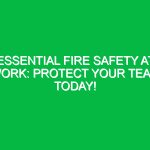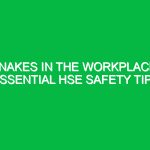Understanding Forklift Truck Safety in the HSE Context
Forklift truck Safety is a critical aspect of Workplace Health, safety, and Environment (HSE) practices. Forklifts are essential machines in warehouses, construction sites, and manufacturing plants, where they facilitate the movement of heavy loads. However, their Operation carries inherent risks. According to the Occupational Safety and Health Administration (OSHA), forklift-related accidents account for a significant number of workplace injuries each year. Therefore, understanding and implementing effective safety protocols is paramount for ensuring a safe working environment. This article delves into essential forklift truck safety tips, providing insights into Best Practices, risk management, and regulatory compliance.
Key Components of Forklift Truck Safety
When discussing forklift truck safety, several key components come into play. Understanding these elements will help create a safer workplace. Here are the primary factors to consider:
1. Operator Training and Certification
One of the fundamental aspects of forklift truck safety is proper training. Operators must undergo comprehensive training that covers not only how to operate the forklift but also how to recognize potential Hazards. Training typically includes:
- Understanding forklift controls and functions.
- Learning Safe Driving Practices.
- Recognizing load capacities and limitations.
- Understanding the importance of proper load handling and stacking.
Certification is often a legal requirement. For example, osha mandates that operators must be trained and evaluated before operating a forklift. This training not only enhances safety but also boosts operator confidence, leading to more efficient operations.
2. Regular Maintenance and Inspections
Regular maintenance is another critical aspect of forklift safety. Forklifts should undergo routine inspections to ensure they are in good working condition. Operators should be trained to perform daily pre-operation checks, which include:
- Checking fluid levels (oil, coolant, etc.).
- Inspecting the brakes and steering.
- Examining the tires for wear and tear.
- Ensuring lights and alarms are functioning properly.
Neglecting maintenance can lead to mechanical failures, increasing the risk of accidents. By adhering to a regular maintenance schedule, companies can mitigate risks and prolong the life of their equipment.
3. Safe Operating Procedures
Establishing safe operating procedures is essential for minimizing accidents. Here are some Best Practices that should be implemented:
- Always wear appropriate Personal Protective Equipment (PPE), such as hard hats, safety shoes, and high-visibility clothing.
- Maintain a safe distance from other workers and obstacles.
- Use horns to signal when entering or exiting blind corners.
- Never exceed the forklift’s load capacity.
- Always ensure that loads are stable and secure before moving.
These procedures can significantly reduce the likelihood of accidents and injuries in the workplace.
4. Hazard Awareness and Risk Assessment
Hazard awareness and risk assessment are vital components of forklift truck safety. Operators must be trained to identify and assess risks associated with their environment. This includes recognizing potential Hazards such as:
- Slippery or uneven surfaces.
- Poorly stacked loads.
- Obstructions in the driving path.
Conducting a thorough risk assessment before operation can help prevent accidents. Employers should encourage a culture of safety where employees feel empowered to report hazards or unsafe practices.
5. Emergency Procedures
In any workplace, having clear emergency procedures is crucial. Forklift operators should be trained on what to do in case of an accident or emergency situation. This includes:
- Understanding how to respond to a tip-over.
- Knowing the emergency shut-off procedures.
- Being aware of first aid protocols in case of injury.
Regular drills and training sessions can ensure that all employees know how to respond effectively during emergencies.
Common Hazards Associated with Forklift Truck Operations
Understanding the common hazards associated with forklift operations is essential for implementing effective Safety Measures. Some of the most prevalent risks include:
1. Collisions and Tip-Overs
Forklifts are prone to tip-overs, especially when carrying heavy or uneven loads. Collisions with pedestrians or other machinery are also common. Ensuring clear visibility, using spotters, and implementing traffic management plans can help mitigate these risks.
2. Load Handling Issues
Improper load handling is a significant safety concern. Overloading a forklift or failing to secure a load can lead to accidents. Operators must be trained to assess the weight and balance of loads before moving them.
3. Poor Visibility
Forklift operators often have limited visibility, especially when carrying loads. It’s crucial to ensure that pathways are clear and that operators are trained to navigate blind corners safely.
Regulations and Standards Governing Forklift Truck Safety
In the HSE context, various Regulations and standards govern forklift truck safety. Compliance with these regulations is not only a legal obligation but also a moral responsibility to ensure employee safety.
1. OSHA Standards
OSHA has established specific standards for forklift operations, outlined in 29 CFR 1910.178. These standards cover operator training, maintenance requirements, and operational Safety Measures. Employers must ensure that all employees comply with these regulations to reduce liability and enhance Workplace Safety.
2. ANSI Standards
The American National Standards Institute (ANSI) also provides guidelines for forklift safety. These guidelines focus on the design, maintenance, and operation of forklifts, ensuring they meet safety requirements.
3. ISO Standards
The International Organization for Standardization (ISO) has developed standards that address safety in the design and operation of forklifts. Adhering to ISO standards can help organizations implement best practices in forklift safety.
Real-Life Examples and Case Studies
Real-life examples illustrate the importance of adhering to forklift truck safety protocols. For instance, a manufacturing company in Pennsylvania faced severe penalties after a forklift accident resulted in a worker’s injury due to inadequate training and lack of safety measures. Investigators found that the operator had not undergone proper training, and the forklift had not been inspected regularly. As a result, the company implemented a comprehensive safety program, which included regular training sessions and maintenance checks, leading to a significant decrease in accidents.
Similarly, a logistics company in California successfully reduced accidents by 50% after introducing a safety incentive program. Employees received rewards for adhering to safe operating procedures, leading to a culture of safety that benefited everyone.
Conclusion
In conclusion, forklift truck safety is an essential aspect of maintaining a healthy and safe workplace. By focusing on operator training, regular maintenance, safe operating procedures, hazard awareness, and emergency preparedness, organizations can significantly reduce the risk of accidents. Compliance with regulations such as OSHA and ANSI further strengthens safety protocols and promotes a culture of safety. As we have seen through real-life examples, prioritizing forklift safety not only protects employees but also enhances overall operational efficiency. It is crucial for employers and employees alike to remain vigilant and committed to forklift truck safety practices, ensuring a safer working environment for everyone involved.


